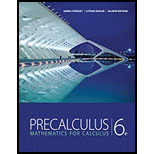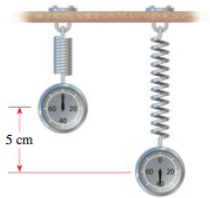
Concept explainers
Hooke’s Law Hooke’s Law states that the force needed to keep a spring stretched x units beyond its natural length is directly proportional to x. Here the constant of proportionality is called the spring constant.
- (a) Write Hooke’s Law as an equation.
- (b) If a spring has a natural length of 5 cm and a force of 30 N is required to maintain the spring stretched to a length of 9 cm, find the spring constant.
- (c) What force is needed to keep the spring stretched to a length of 11 cm?

(a)
To express: Hooke’s law for spring as equation.
Answer to Problem 29E
Hooke’s law for spring is
Explanation of Solution
Hooke’s law:
The force required to keep the spring stretched beyond the natural length is directly proportional to the extension of spring beyond natural length.
Mathematically,
Here,
Thus, Hooke’s law as an equation is
(b)
To find: The spring constant
Answer to Problem 29E
The value of spring constant is
Explanation of Solution
Given:
Natural length of spring (
Force required to stretch it up to
Calculation:
The spring is stretched up to
Use Hooke’s Law,
Substitute, 30 for
Multiply both the sides by
Thus, the value of
(c)
To find: The force required to keep the spring stretched to
Answer to Problem 29E
The force required is
Explanation of Solution
Given:
The stretched length of the spring is
Calculation:
The natural length of spring is
Use Hooke’s Law,
Substitute 6 for
Thus, the value of
Chapter 1 Solutions
EBK PRECALCULUS: MATHEMATICS FOR CALCUL
- Do the Laplace Transformation and give the answer in Partial Fractions. Also do the Inverted Laplace Transformation and explain step-by-step.arrow_forward纟 W₂ Find S-FX SB.MXarrow_forward4. The revenue (in thousands of dollars) from producing x units of an item is R(x)=8x-0.015 x². a) Find the average rate of change of revenue when the production is increased from 1000 to 1001 units.arrow_forward
- MATH 122 WORKSHEET 3 February 5, 2025 . Solve the following problems on a separate sheet. Justify your answers to earn full credit. 1. Let f(x) = x² - 2x + 1. (a) Find the slope of the graph of y = f (x) at the point P = (0,1) by directly evaluating the limit: f'(0) = lim ( f(Ax) - f(0) Ax Ax→0 (b) Find the equation of the tangent line 1 to the graph of ƒ at P. What are the x and y intercepts of 1 ? (c) Find the equation of the line, n, through P that is perpendicular to the tangent line l. (Line n is called the normal line to the graph of f at P.) (d) Sketch a careful graph that displays: the graph of y = f (x), its vertex point, its tangent and normal lines at point P, and the x and y intercepts of these lines. Bonus: Find the coordinates of the second point, Q, (QP), at which the normal line n intersects the graph of f. 2. A rock is thrown vertically upward with an initial velocity of 20 m/s from the edge of a bridge that is 25 meters above a river bed. Based on Newton's Laws of…arrow_forward3. Use the graph for problem #35, p175 to answer the questions. The average price (in cents) per gallon of unleaded gasoline in the United States for the years 2010 to 2019 is shown in this chart. Find the average rate of change per year in the average price per gallon for each time period. Source: U.S. Energy Information Administration. a) 2010 to 2013 b) 2012 to 2018 c) 2014 to 2019arrow_forward4. Researchers at Iowa State University and the University of Arkansas have developed a piecewise function that can be used to estimate the body weight (in grams) of a male broiler during the first 56 days of life according to W(t)=48+3.64t+0.6363²+0.00963 t³ if 1St≤28, -1004+65.8t if 28arrow_forward3. Given the function h(x)=(x²+x-12 if x≤1 3-x if x>1' a) Graph the function h(x). Make the graph big enough to be easily read using the space below. Be sure to label all important aspects of the graph. b) Find all values of x where the function is discontinuous. c) Find the limit from the left and from the right at any values of x found in part b.arrow_forward2. Find the instantaneous rate of change for each function f(x)=2x²-x+3 at x=0..arrow_forward4x-3 2. Determine the interval over which the function is continuous. x+4arrow_forward1. Find the average rate of change for the following functions over the given intervals. a) f(x)=4x-2x²+3x between x=-1 and x=4 b) y lnx between x=1 and x=4arrow_forward1. Find all values x=a where the function is discontinuous, determine if the discontinuity is removable or non- removable. For each value of x, give the limit of the function as x approaches a. Be sure to note when the limit doesn't exist and explain how you know. a) f(x)= 2-x x²(x+5) b) f(x)= x²-9x x²+3x c) p(x)=-3x²+2x²+5x-8arrow_forwardDo the Laplace Transformation and give the answer in Partial Fractions. Also do the Inverted Laplace Transformation and explain step-by-step.arrow_forwardarrow_back_iosSEE MORE QUESTIONSarrow_forward_ios
 Calculus: Early TranscendentalsCalculusISBN:9781285741550Author:James StewartPublisher:Cengage Learning
Calculus: Early TranscendentalsCalculusISBN:9781285741550Author:James StewartPublisher:Cengage Learning Thomas' Calculus (14th Edition)CalculusISBN:9780134438986Author:Joel R. Hass, Christopher E. Heil, Maurice D. WeirPublisher:PEARSON
Thomas' Calculus (14th Edition)CalculusISBN:9780134438986Author:Joel R. Hass, Christopher E. Heil, Maurice D. WeirPublisher:PEARSON Calculus: Early Transcendentals (3rd Edition)CalculusISBN:9780134763644Author:William L. Briggs, Lyle Cochran, Bernard Gillett, Eric SchulzPublisher:PEARSON
Calculus: Early Transcendentals (3rd Edition)CalculusISBN:9780134763644Author:William L. Briggs, Lyle Cochran, Bernard Gillett, Eric SchulzPublisher:PEARSON Calculus: Early TranscendentalsCalculusISBN:9781319050740Author:Jon Rogawski, Colin Adams, Robert FranzosaPublisher:W. H. Freeman
Calculus: Early TranscendentalsCalculusISBN:9781319050740Author:Jon Rogawski, Colin Adams, Robert FranzosaPublisher:W. H. Freeman
 Calculus: Early Transcendental FunctionsCalculusISBN:9781337552516Author:Ron Larson, Bruce H. EdwardsPublisher:Cengage Learning
Calculus: Early Transcendental FunctionsCalculusISBN:9781337552516Author:Ron Larson, Bruce H. EdwardsPublisher:Cengage Learning





